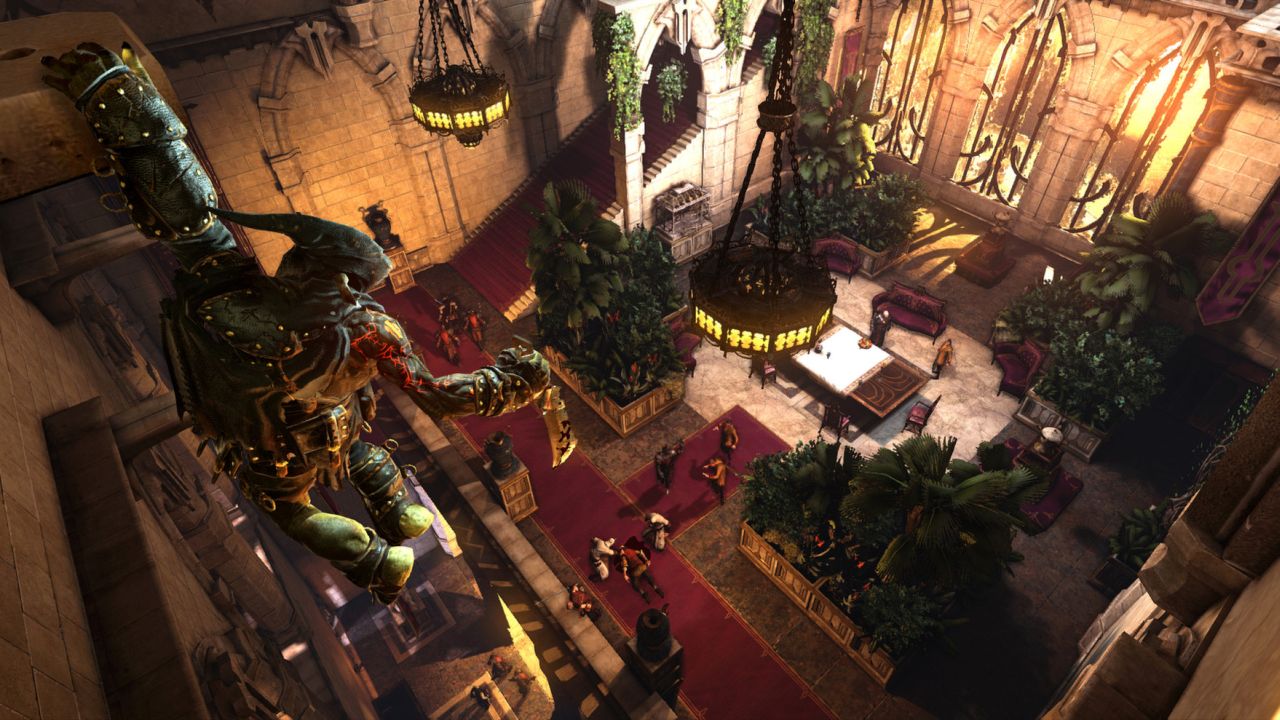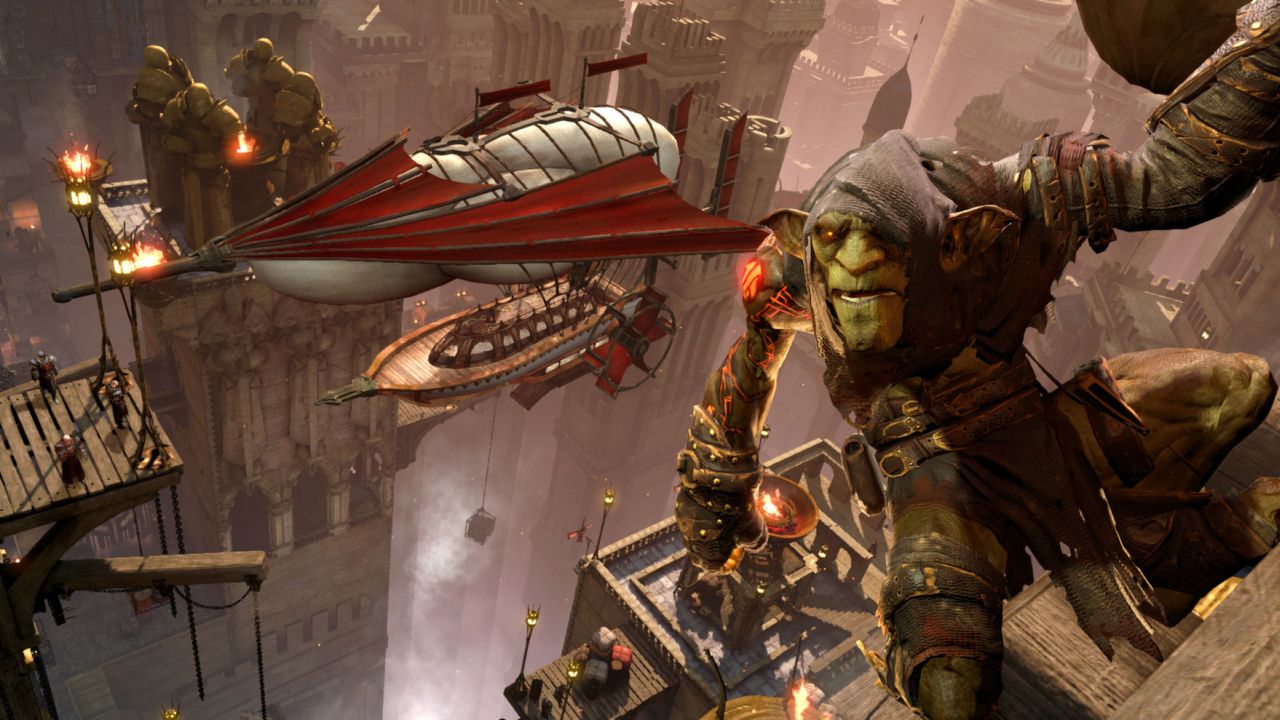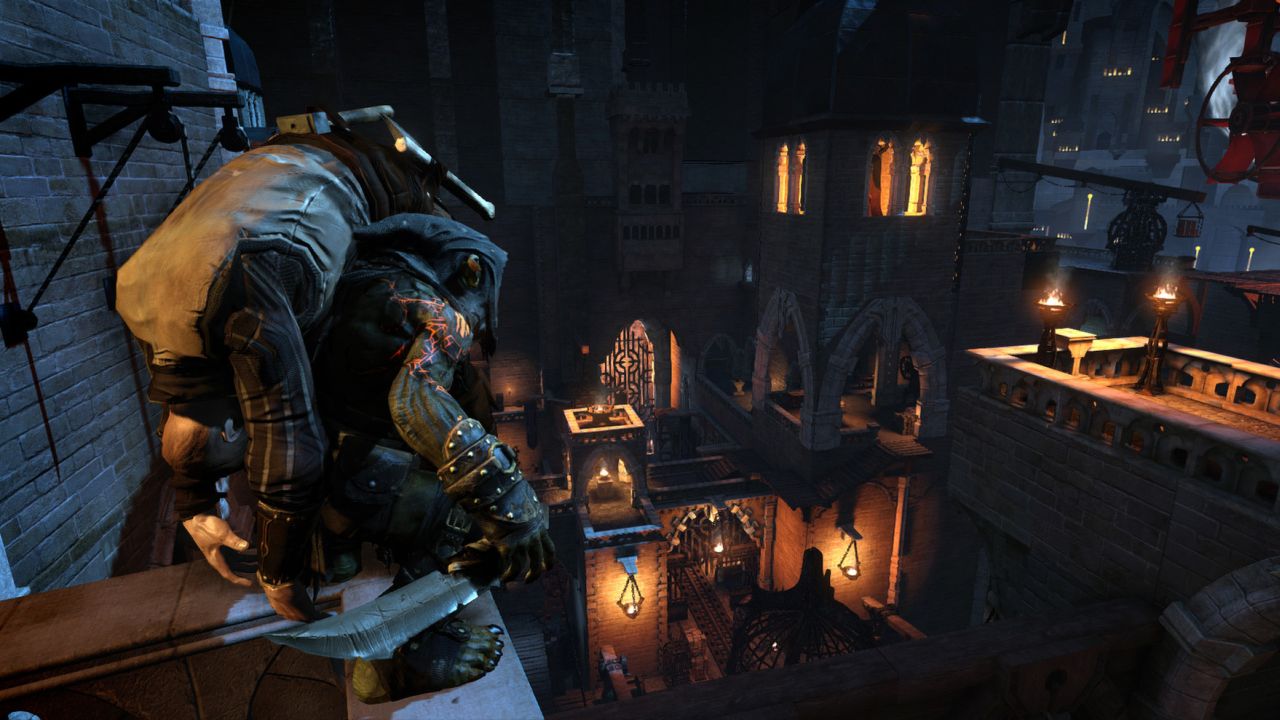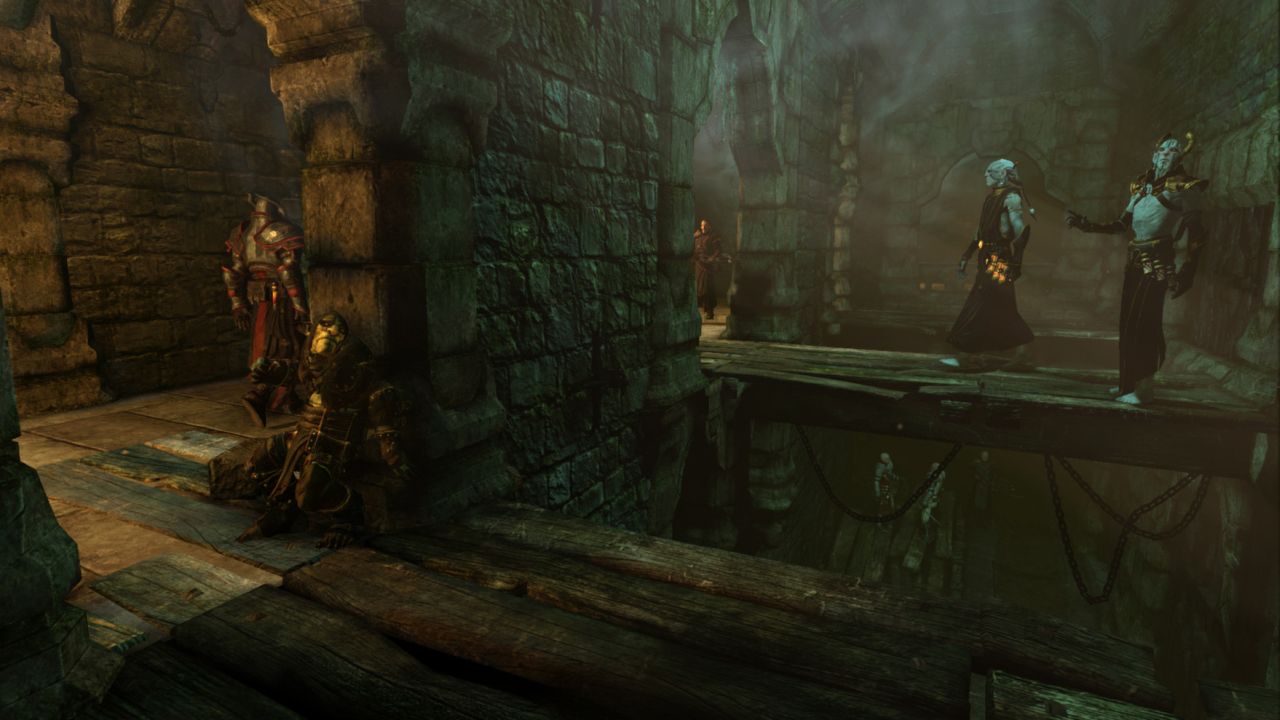Styx: Master of Shadows Review
Styx: Master of Shadows is a stealth game. Not a game with stealth mechanics – though that is most certainly the case, rest assured – but a game that somewhat appropriately appears to have passed everybody by with nary a blip on the radar. What happened to the triple-A hype machine, guys? I’ve grown so used to its endless stream of meaningless marketing noise that hearing it fall silent is an event all on its own. Every time I’ve brought this game up in conversation it’s always been the same story: a confused look, a moment of silence, then a “what’s that?” It’s not as if the premise is especially disinteresting either: you’re a greasy green goblin – the titular Styx – who has infiltrated the Tower of Akenash, an enormous vertical city built to cage a magical tree that extends high into the sky. Why cage it? It’s probably got something to do with the tree’s amber, the convenient magical plot-insulator which can deform living creatures, make them immortal, fuel magical powers, and presumably also power nuclear fusion reactors. Whatever its properties, Styx wants to get his grubby little hands on as much of it as he can, and that means getting to the tree’s heart, an entity sealed away behind a thousand locked doors, barred gates, and guards with comically British accents. Guess how he’s going to bypass them?

Really though, it’s almost a shame that Styx has gone relatively unnoticed like this – goodness me, that was an ominous ‘almost’ – because it actually does a few things right that other games consistently fail to understand. You have the ability to make every interactive element around you glow like a radioactive stoplight, which is quickly becoming a prerequisite for stealth games since it’s apparently the only way to consolidate the graphic designer’s oh-so-precious vision with the realities of trying to keep track of dark, muddy, grubby objects in a dark, muddy, grubby environment. Crucially, however, it only functions for a few seconds at a time and consumes amber – your mana, essentially – on use, handily discouraging you from just having it on all the time and making it look like somebody flew over the Tower of Akenash with a crop duster full of Fanta. The platforming is also a lot less restrictive than most stealth games, giving you both the freedom and the consequences of being able to leap wherever and whenever you please, rather than just inorganically clamping you onto rails that occasionally demand you press the ‘jump’ button. It lets you make jumps that the developers probably didn’t even anticipate, which is great, but it also opens up the possibility that you’ll botch the whole thing, fall off a building, and land in the midst of some really ill-humoured guards. And assuming that it’s entirely your fault, that’s fantastic.
Unfortunately, when you do royally screw up, things go down the plughole so fast that the game might as well just skip the formalities and dump you straight back to the last checkpoint. My mark of a good stealth game is one where ‘unseen, unheard’ is the ultimate goal, but you can still salvage things if you, say, tread on a local stray’s tail by accident, and while Styx technically allows you to do that, it tries its absolute best to sabotage its own intentions. Get too close to an alerted enemy and the game will assume – with a staggering display of bleach-drinking intellect – that you want to fight them, locking you into a nigh-inescapable duelling stance that leaves you circling around them gazing dreamily into their eyes while every other guard in the immediate vicinity prepares to cut you into a million sweary green giblets. Even if you manage to avoid that fate, there’s always a chance that you’ll get turned into a walking knife block by the hundred or so throwing knives that are ditched at you by the perfect-aim night-vision androids that the tower apparently employs. Sometimes the cheap façade completely collapses and there are straight up instant-failure sections, but with the rest of the game being how it is, the distinction is hardly large enough to be worth noting. All it really does is narrow the gap between botching things and being deposited at the ‘game over’ screen.

Alright, so what’s the stealth like if we don’t slip and fall into a stack of wicker baskets? Hmm. Competent, but derivative. It’s pretty clear that Styx mailed out for the ACME Stealth Protagonist’s Starter Kit – containing a decoy, some throwing knives, the aforementioned amber-vision, the ability to turn nearly-invisible in a dingy corner and completely invisible if you’re really rubbish – but it does its job, at least. You can distract people with noises, kill them, then stuff their bodies into cupboards and hope nobody is going to open them while looking for the silverware, or just find a way around if you want the arbitrary end-of-level bonus. Torches, vents, guards, pointless climbable wall fixtures. Eyes glazing over yet? Arms feeling a little heavy? Maybe a bit of déjà vu? Of course; you’ve been here before. We’ve all been here before. Isn’t there some kind of rule that games have to have at least one stupid gimmick? I could really go for one of those right now.
What do stealth mechanics matter compared to good level design though, eh? Styx doesn’t actually do too badly here, although it has definitely spent more than a few nights hunched over Batman: Arkham Asylum, taking notes by the light of the monitor. There’s a fairly strong emphasis on verticality, letting you leap from rafter to rafter, scale walls and hide in the wings, which is always a welcome choice over painstakingly mapping out patrol paths on the ground level, although since falling off means almost certain discovery – and hence, getting stabbed in the face by a medieval British stereotype – it almost feels at times like the platforming takes precedence over the stealth itself: either successfully follow the route that lets you bypass this area entirely, or waste your time and sanity trying to actually sneak past. Hardly a difficult choice to make.
As for the levels themselves, they don’t quite elicit an exasperated sigh, so that’s something. All are linear to a certain extent, some more than others – in the sense that you progress through them from point A to point B in a very definite direction – but most of them are happy to luxuriously sprawl out on the sofa and allow you to venture off the trail a bit. There’s the occasional obnoxious bottleneck packed with armed guards – the stealth game equivalent of mountaineering halfway up a cliff face only to find a group of workmen industriously polishing an unforeseen overhang – but by and large the levels do alright. They aren’t a patch on the old Thief games, either in terms of size or non-linearity, but if the Thief reboot itself is anything to go by then that technology has long since been lost to the mists of time, so I suppose developers are just hoping we’ll pretend that they never existed at all. If anything, the problem is not having places to go, but reasons to be there; Styx struggles desperately for rewards to draw you off the beaten path, and it’s not a struggle it comes out on top of. Without any kind of money or loot system, all the game can hope to do is try to tempt you with hidden consumables, occasional side-quests, and collectibles, none of which really justify the punishment you’ll receive if you’re caught while seeking them out. Sure, I’d love to have an extra life potion or throwing knife handy, but Styx is a frail little monstrosity with matchsticks for arms and an aggressively small inventory, so stockpiling is essentially impossible. The collectibles, as always, are utterly arbitrary and about as rewarding as picking gum off the undersides of park benches. Completing side-quests grants you more skill points at the end of each mission, so they’re certainly a valid option, but since they’re always loudly advertised by the siren’s call of the objective marker it’s not so much ‘exploration’ as it is ‘making a beeline for the glowing triangle’, which is pretty much exactly what I did.

Or rather, that’s exactly what I like to imagine my handsome, skilful, alternate universe self did. What actually happened made Styx look like the unfortunate victim of a massive hangover that saw him slip off ledges, stumble over obstacles and fall right in the middle of guards’ illicit poker games, which is a long way of saying that that his movement is clumsier than that of a fat dog on a soft mattress. Master of Shadows, my foot. It feels as if the game really aspires to having a nimble, agile protagonist, but all it has to work with is a bog-standard movement system that periodically dozes off when it thinks nobody’s looking. Time and time again I’d die because I jumped just a tiny bit early, grabbed a ledge I didn’t mean to, or just angled my leap slightly off-kilter. In a normal humdrum third-person action game it’d be bearable at the very least, but when a single mistake inevitably means being swarmed by grouchy rejected Fable NPCs – and, more often than not, being sent back ten minutes because the autosaves are so unreliably spaced – it just cements this game’s growing reputation for pushing you into a ditch and asking why you’re all muddy.
And I’m sorry, Styx, but this ‘dark fantasy’ angle you’re pushing really isn’t working. It’s not for a lack of trying, mind; somebody appears to have gone through the script with a big book of naughty words and pencilled in a nice F-bomb or two wherever they could squeeze one in, for instance, and there’s certainly no shortage of brutish guards to slit open from head to toe with your filthy oversized goblin knife, but the game’s heart really isn’t in it. There’s no attempt to tackle a serious central matter or gritty conflict; it’s just a regular fantasy where everybody’s just kind of a jerk: guards, citizens, even Styx. Especially Styx, actually. It doesn’t help his image that the game starts with a bad case of plot-convenient amnesia and a load of really poorly-organised sequences that may or may not be in chronological order, neither of which get resolved until the twist at the midway point. Fair go, Styx: it’s a pretty good twist, one that explained a lot and hit me like a lump of pond muck launched from a trebuchet, but you do realise that hinging everything on it meant that I spent half the game wandering around in the – ah-hah – dark, right? You can’t just have an unsympathetic crusty goblin like Styx doing things because the mysterious voice in his head tells him to and expect anybody to care about his plight, even if everybody else in the tower appears to be about twenty percent more villainous than he is.

Overall Styx is the kind of game that can do little more than extract a long, drawn-out, tired sigh. When it’s at the tip-top of its game, it’s an utterly average stealth-em-up with a whiff of plot intrigue on the side. Perhaps, if it held that standard throughout and you were really desperate, that’d be enough all on its own, but it’s a short-lived accolade that – between awkward controls, level design whiffs, and generally being about as forgiving as playing ‘chicken’ with a freight train – never lasts long. Despite my initial apprehensions, Styx didn’t sneak under everybody’s radar at all: they saw it, noted it, recognised its unmistakeable air of mediocrity, and promptly discarded all memories of it. As soon as I can find a heavy enough mallet, so will I.
